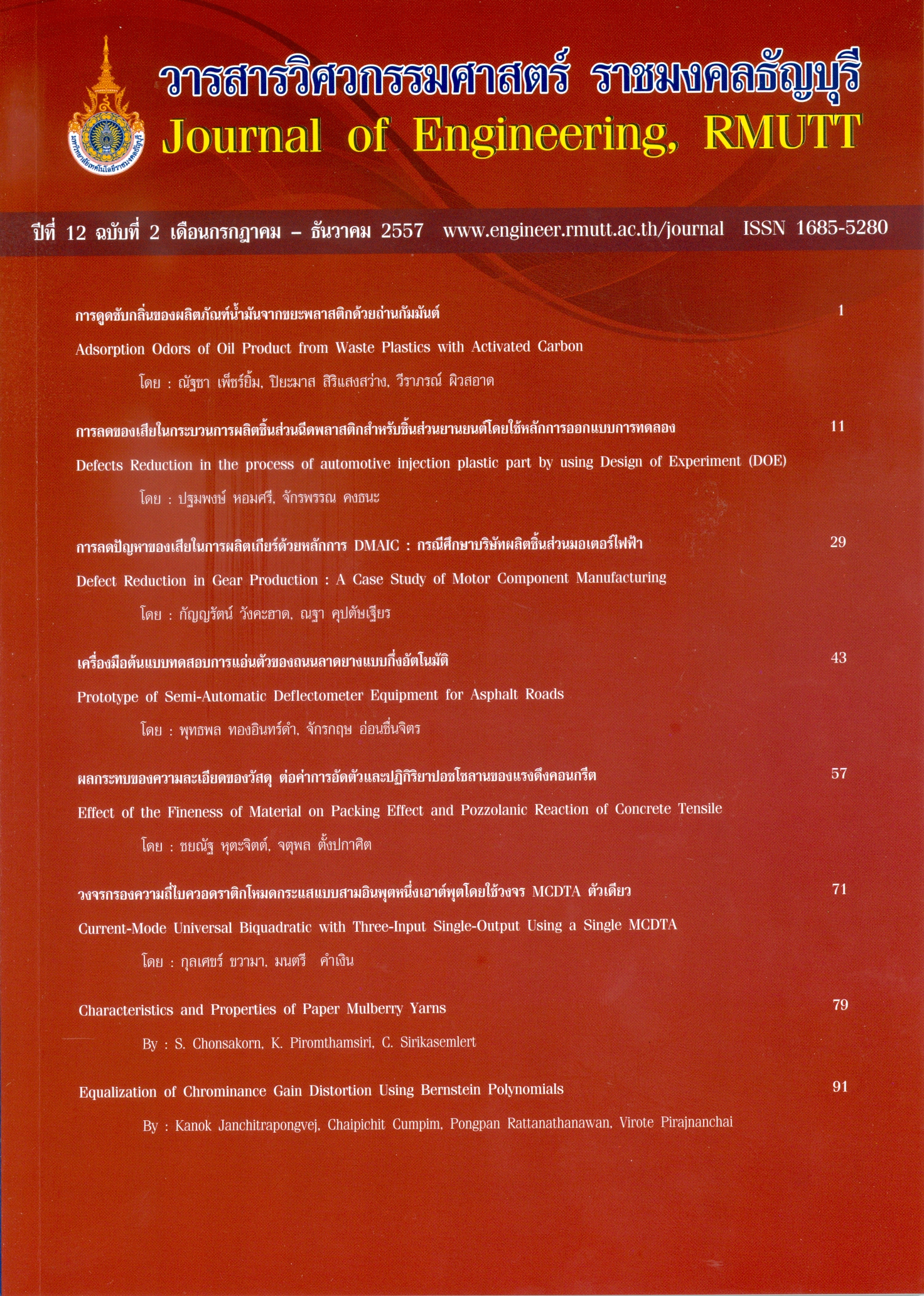Characteristics and Properties of Paper Mulberry Yarns
Main Article Content
Abstract
The objective of this research was to determine the characteristics and physical properties of paper mulberry yarns spun by different methods. The materials used for this study were the inner barks of paper mulberry trees (Broussonetia papyrifera (L.) Vent.), between 6 to 12 months old. The paper mulberry yarns were spun by the modified hemp spinning method using 2, 4 and 6 mm strips and the modified cotton spinning method using 3.5, 5 and 6.5 cm fibers. The yarns produced were tested for physical properties according to the American Society of Testing Materials (ASTM) standards. It was found that the modified hemp spinning methods produced much smoother yarns, but they were still uneven in texture and classified as grade C. In contrast, the modified cotton spinning methods produced fuzzy and rough yarns, more uneven in texture and classified as below grade D. The paper mulberry yarns spun by different methods statistically had different yarn count, yarn twist, yarn breaking strength and yarn elongation at the .01 level. The yarn spun by the modified hemp spinning method using 6 mm strips had the highest yarn count, breaking strength and elongation, while the yarn spun by the modified cotton spinning method using 3.5 cm fibers had the highest yarn twist.
Article Details
The manuscript, information, content, picture and so forth which were published on Frontiers in engineering innovation research has been a copyright of this journal only. There is not allow anyone or any organize to duplicate all content or some document for unethical publication.
References
Whistler, W.A. and C.R. Elevitch.Paper mulberry. [online] Available :http://traditionaltree.org (April 03,2007).
Cong, X., H. Wen and Z. Riu. 2006.The Wood Characteristic and Pulping Performance of Plantation Paper Mulberry. China Pulp & Paper. 09: 1.
Punsuvon, V, and Y.Kobayashi. n.d.Steam Explosion Pulping Paper Mulberry Bast. The Research Project for Higher Utilization of Forestry and Agricultural Plant Materials in Thailand (HUFA),Kasetsart Agricultural and Agro-industrial Product Improvement Institute(KAPI), Kasetsart University, Bangkok,Thailand.
Ujin, S,, S. Niyom, S. Supawadee, S.Prisnar and V. Haruthaithanasan.2000. Postharvest Technology of Paper Mulberry Bark, pp. 57-67. In Proceeding of the 38th Kasetsart University Annual conference,1-4 February 2000, Kasetsart University, Bangkok Thailand.
Taylor, M.A. .1997. Technology of Textile Properties. 3'd ed. Forbes Publications Ltd., London, England.
Lei, J., L. Sheng, K, YANG, Z. Yi and Z Chun. 2007. Analyses on Chemical Composition Fiber Morphology and Pulping Properties of Broussonetia papyrifera Bark Produced in Dry-hot Valley of the Jinshajiang River. Advanced Materials Research.68-69:357-360.
Sittidilokratna, C,, S.Suthirawut, L.Chitradon, V. Punsuvon, P. Vaithanomsat and P. Siriacha. 2007.Screening of Pectinase Producing Bacteria and Their Efficiency in Biopulping of Paper Mulberry Bark. Science Asia. 33: 131-135.
Liu ,L., J. Cao, J. Huang, Y. Cai and J.Yao. 2010. Extraction of pectins with different degrees of esterification from mulberry branch bark. Bioresource Technology.101:3268-3273.
Chonsakorn S. 2014. Characteristics and Properties of Paper Mulberry Yarn and Fabric. Doctor of Philosophy (Tropical Agriculture) Thesis. Kasetsart University
ASTM International. 2005. Standard Test Methods for Testing and Materials. ASTM Standards Book of Standard. vol. 07.01: D 76-D4391.
Collier, B.J. and H.H. Epps. 1999.Textile Testing and Analysis.Merrill, an imprint of Prentice Hall, Inc., New Jersey, U.S.A.
Home Science. Function of Clothing and Household Uses of Fabrics.[online] Available : http://nios.ac.in (22 November 2015).


